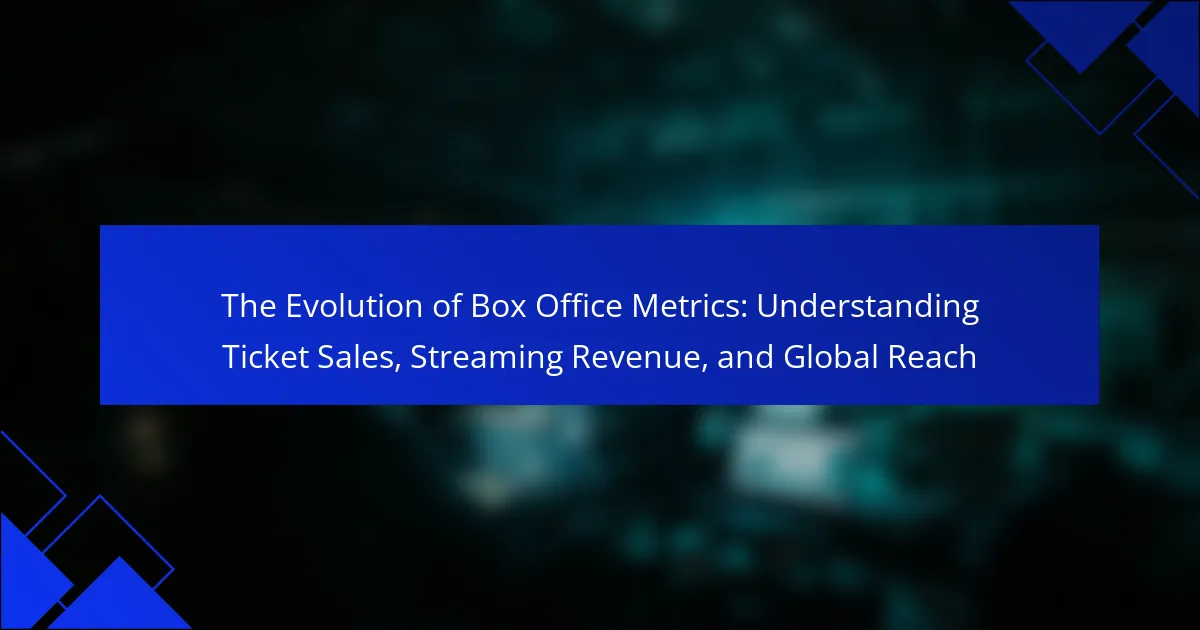
What are Box Office Metrics and Why are They Important?
Box office metrics are quantitative measures used to evaluate the financial performance of films. These metrics include gross revenue, ticket sales, and attendance figures. Box office metrics are important because they provide insights into a film’s popularity and market viability. They help studios and investors make informed decisions regarding production, marketing, and distribution. For example, the global box office revenue for the film “Avengers: Endgame” exceeded $2.798 billion, highlighting its massive success. Additionally, box office metrics can influence future projects and franchise development based on audience demand.
How have box office metrics evolved over time?
Box office metrics have evolved significantly over time. Initially, box office revenue was primarily measured through ticket sales at physical theaters. In the early 20th century, metrics focused on domestic gross revenue. By the late 20th century, international box office performance began to be tracked, reflecting a growing global audience. The introduction of digital technology in the 2000s transformed metrics to include online ticket sales. Streaming services have further changed the landscape by introducing new revenue models. Today, box office metrics also encompass streaming revenue and digital rentals. The rise of data analytics has enabled more precise tracking of viewer demographics and preferences. Overall, box office metrics have expanded from simple ticket sales to complex, multi-faceted financial indicators.
What historical factors influenced the development of box office metrics?
The development of box office metrics was influenced by several historical factors. The rise of cinema in the early 20th century marked the beginning of ticket sales tracking. Initially, box office revenue was recorded informally. The introduction of standardized ticketing systems in the 1920s allowed for more accurate sales data. The Hollywood studio system further propelled the need for metrics to gauge film success. The post-World War II boom in cinema attendance highlighted the importance of box office numbers. Technological advancements, such as computerized sales tracking in the 1980s, improved data collection. The emergence of multiplex theaters in the 1990s changed how box office metrics were measured. Finally, the advent of digital streaming platforms has led to new metrics for evaluating film performance beyond traditional box office sales.
How did technological advancements impact box office tracking?
Technological advancements significantly improved box office tracking. These advancements include digital ticketing systems and real-time data analytics. Digital ticketing allows for accurate sales reporting. Real-time analytics enable studios to monitor performance instantly. Enhanced data collection methods provide detailed consumer insights. This leads to better marketing strategies and targeted advertising. Additionally, mobile applications facilitate easier access to box office information. As a result, stakeholders can make informed decisions quickly.
What are the key components of box office metrics?
The key components of box office metrics include gross revenue, ticket sales, and attendance figures. Gross revenue represents the total income generated from ticket sales before any deductions. Ticket sales quantify the number of tickets sold for a film. Attendance figures indicate the number of viewers who attended screenings. These metrics help gauge a film’s financial performance and popularity. For instance, in 2022, the global box office grossed approximately $25 billion, reflecting the industry’s recovery post-pandemic. Analyzing these components provides insight into market trends and audience preferences.
What is the significance of ticket sales in box office metrics?
Ticket sales are a critical component of box office metrics. They directly indicate a film’s popularity and financial success. High ticket sales often correlate with positive audience reception and effective marketing strategies. For instance, the 2019 film “Avengers: Endgame” grossed over $2.798 billion, showcasing the impact of massive ticket sales on overall box office performance. Additionally, ticket sales influence a film’s longevity in theaters. Films with strong initial sales tend to remain in theaters longer, maximizing revenue potential. Overall, ticket sales provide essential insights into audience engagement and market trends in the film industry.
How does streaming revenue contribute to overall box office metrics?
Streaming revenue enhances overall box office metrics by providing additional income streams. It allows studios to monetize films beyond traditional ticket sales. For example, a film that performs moderately at the box office can still achieve financial success through streaming platforms. In 2021, films like “Zack Snyder’s Justice League” gained significant viewership on HBO Max, influencing future box office strategies. This shift indicates that studios are increasingly considering streaming performance when evaluating a film’s overall success. Streaming also extends a film’s lifespan, as it continues to generate revenue long after its theatrical release. The combined revenue from box office and streaming creates a more comprehensive view of a film’s financial performance.

How do Ticket Sales Reflect Box Office Performance?
Ticket sales are a direct indicator of box office performance. Higher ticket sales typically correlate with greater revenue generated at the box office. For instance, a film that sells millions of tickets often ranks among the highest-grossing films. This relationship is evidenced by the success of blockbuster films, which can earn over $1 billion in ticket sales. Additionally, ticket sales provide insights into audience demand and market trends. Tracking ticket sales over time can reveal patterns in viewer preferences. For example, during peak seasons, ticket sales may surge, reflecting increased interest in specific genres or franchises. Overall, ticket sales serve as a vital metric for assessing a film’s financial success and popularity.
What factors influence ticket sales for films?
Ticket sales for films are influenced by multiple factors. Key factors include marketing strategies, star power, and critical reviews. Marketing campaigns create awareness and generate interest among potential audiences. Star power attracts viewers due to the popularity of actors. Critical reviews impact public perception and can drive or deter ticket purchases. Additionally, competition from other films can affect sales. Seasonal timing, such as holidays or summer breaks, also plays a role. Audience demographics, including age and preferences, further influence ticket sales. Historical data shows that films with strong marketing and positive reviews tend to perform better at the box office.
How does marketing affect ticket sales?
Marketing directly influences ticket sales by increasing awareness and generating interest. Effective marketing strategies attract potential attendees through targeted promotions. This includes advertising campaigns, social media engagement, and partnerships. Research shows that events with strong marketing see up to 30% higher ticket sales. Additionally, marketing creates a sense of urgency through limited-time offers. This tactic encourages quick purchasing decisions. Furthermore, word-of-mouth generated by marketing efforts can lead to increased sales. In summary, marketing is essential for maximizing ticket sales across various events.
What role do release dates play in ticket sales performance?
Release dates significantly impact ticket sales performance. They determine the timing of a film’s entry into the market. Strategic release dates can capitalize on holidays or weekends, maximizing audience turnout. For instance, films released during summer or holiday seasons often see higher ticket sales. A study by the Motion Picture Association found that films released during peak periods can earn up to 40% more in box office revenue. Conversely, poorly timed releases can lead to lower sales due to competition or audience availability. Thus, release dates are crucial for optimizing box office performance.
How are ticket sales measured and reported?
Ticket sales are measured by the number of tickets sold and the revenue generated from those sales. Box office systems track these figures in real-time during a film’s release. Data is collected from various sales channels, including theaters, online platforms, and ticketing services. This information is then aggregated to provide total sales figures for specific time periods. Reporting typically includes daily, weekly, and cumulative totals. Industry organizations, like the Motion Picture Association, often publish these metrics. They provide insights into trends and performance across different markets and demographics. Accurate reporting is essential for studios and investors to assess a film’s financial success.
What methodologies are used to track ticket sales?
Ticket sales are tracked using various methodologies including point-of-sale systems, online ticketing platforms, and sales reporting tools. Point-of-sale systems collect data directly at the venue. Online ticketing platforms, such as Ticketmaster, provide real-time sales analytics. Sales reporting tools aggregate data from multiple sources for comprehensive insights. These methodologies allow for accurate tracking of ticket sales trends and consumer behavior. Historical data shows that accurate tracking can improve marketing strategies and sales forecasting. For instance, a study by the Motion Picture Association highlights that precise sales tracking has led to a 15% increase in revenue for theaters using advanced analytics.
How do different regions report ticket sales data?
Different regions report ticket sales data through various methods and platforms. In North America, data is typically gathered by organizations like the Motion Picture Association. They compile statistics from major theaters and studios. Europe often relies on national film agencies to collect and report sales figures. These agencies may use surveys and direct reports from cinemas. In Asia, ticket sales data is often reported by local distributors and cinema chains. They may utilize digital ticketing systems for accurate tracking. Each region may also adjust reporting methods based on local market conditions. For example, some regions might emphasize digital sales over physical ticket sales. This variation reflects the diversity in cinema consumption and distribution practices globally.

What Role Does Streaming Revenue Play in Box Office Metrics?
Streaming revenue significantly impacts box office metrics by providing additional financial data for film performance. It supplements traditional box office figures, offering insights into audience engagement post-theatrical release. Streaming platforms often release viewership statistics that can indicate a film’s popularity. This data can influence future box office projections and marketing strategies. For example, films with strong streaming performance may see increased interest in theatrical re-releases. Additionally, the rise of streaming services has shifted how studios evaluate a film’s overall success. According to a 2021 report by the Motion Picture Association, films that perform well on streaming platforms can enhance their box office revenue through increased word-of-mouth and social media buzz. Thus, streaming revenue plays a crucial role in the evolving landscape of box office metrics.
How has the rise of streaming platforms affected traditional box office metrics?
The rise of streaming platforms has significantly impacted traditional box office metrics. Box office revenues have declined as audiences shift to streaming services for convenience and accessibility. In 2020, global box office revenue dropped by 71% due to the COVID-19 pandemic and the surge in streaming. Streaming platforms, such as Netflix and Disney+, have reported substantial subscriber growth, further diverting potential ticket sales. The average ticket price has also seen fluctuations as a result of this shift. Additionally, streaming releases often bypass traditional theatrical windows, leading to fewer films generating significant box office returns. The emergence of hybrid release models has further complicated box office performance tracking. Overall, streaming platforms have redefined audience consumption patterns, directly affecting box office performance metrics.
What are the implications of streaming revenue on box office earnings?
Streaming revenue impacts box office earnings by creating competition for audience attention. As more viewers opt for streaming services, fewer may attend theaters. This shift can lead to a decrease in ticket sales. For instance, in 2020, the COVID-19 pandemic accelerated this trend, with many films releasing simultaneously on streaming platforms. According to a report by the Motion Picture Association, global box office revenue dropped to $12 billion in 2020, down from $42.5 billion in 2019. The rise of streaming also influences film budgets and marketing strategies. Studios may invest more in streaming releases, affecting theatrical distribution plans. Overall, streaming revenue can diminish box office performance and alter industry dynamics.
How do subscription models compare to traditional ticket sales?
Subscription models provide ongoing access to content for a fixed fee, unlike traditional ticket sales which require individual purchases for each event. Subscription models often lead to higher customer retention rates. Customers enjoy the flexibility of accessing multiple events or services over time. Traditional ticket sales can yield higher immediate revenue per event but may result in inconsistent attendance. According to a report by PwC, subscription services have seen a growth rate of 20% annually in recent years. This shift indicates a preference for subscription over single-event purchases among consumers.
What are the trends in streaming revenue related to box office performance?
Streaming revenue increasingly correlates with box office performance. Successful films often see higher streaming revenues post-release. For instance, blockbuster films that gross over $100 million typically experience a surge in streaming subscriptions. According to a 2022 report by the Motion Picture Association, films that perform well at the box office can boost streaming platform viewership by up to 30%. Additionally, studios are releasing films on streaming platforms sooner after theatrical release, capitalizing on initial box office success. This trend indicates a strategic shift to maximize revenue across multiple channels.
How do exclusive releases on streaming platforms impact box office results?
Exclusive releases on streaming platforms generally lead to a decrease in box office results. When films are available for streaming, audiences may choose to watch them at home instead of going to theaters. This shift in viewing preference can reduce ticket sales significantly. For instance, a study by the Motion Picture Association found that simultaneous streaming releases can lower box office revenue by as much as 30%. Additionally, exclusive streaming releases create competition for traditional theaters. This competition can divert potential viewers away from cinemas. Overall, the trend of exclusive streaming releases has reshaped audience behavior and impacted box office performance negatively.
What is the future of streaming revenue in relation to box office metrics?
The future of streaming revenue will likely surpass box office metrics. Streaming platforms are experiencing significant growth in subscriber numbers and revenue. In 2022, global streaming revenue reached approximately $70 billion, while box office revenue was around $25 billion in the same year. The convenience of on-demand access drives consumer preference for streaming. Additionally, the COVID-19 pandemic accelerated the shift towards streaming, as many theaters faced closures. Industry experts predict that by 2025, streaming revenue could exceed $100 billion. This trend indicates a fundamental change in how audiences consume content, favoring streaming over traditional box office sales.

How Does Global Reach Influence Box Office Metrics?
Global reach significantly influences box office metrics by expanding the potential audience for films. A wider distribution increases ticket sales across various international markets. For example, films like “Avengers: Endgame” grossed over 60% of their total revenue from international markets. This indicates that global audiences are crucial for maximizing box office performance. Additionally, films with strong global marketing strategies tend to perform better. The international appeal often correlates with higher overall earnings. Therefore, global reach is a key factor in determining a film’s financial success.
What are the challenges of measuring global box office performance?
Measuring global box office performance presents several challenges. One major challenge is the inconsistency in reporting practices across different countries. Data collection methods vary significantly, leading to discrepancies in reported figures. Currency fluctuations also complicate the comparison of box office earnings internationally. Additionally, varying definitions of what constitutes box office revenue can create confusion. For instance, some markets may include streaming revenues, while others focus solely on ticket sales. The rise of digital platforms further blurs these lines, as many films now release simultaneously in theaters and on streaming services. Moreover, cultural factors influence ticket sales, making it difficult to draw direct comparisons between markets. Lastly, the impact of piracy and illegal streaming can distort actual box office performance, as these factors are hard to quantify.
How do cultural differences affect box office success in various regions?
Cultural differences significantly impact box office success in various regions. Films resonate differently based on local customs, values, and preferences. For instance, humor styles vary widely; what is funny in one culture may not be in another. Action sequences might appeal more in regions favoring thrillers, while dramas may do better in areas valuing storytelling.
Moreover, marketing strategies must align with cultural nuances to attract audiences effectively. Language, symbolism, and themes must be culturally relevant to engage viewers. For example, a film that portrays family values may perform exceptionally well in cultures that prioritize familial bonds.
Statistics support this notion. The 2019 film “Crazy Rich Asians” succeeded in the U.S. due to its representation of Asian culture, which resonated with a diverse audience. Conversely, films lacking cultural relevance often underperform, as seen with several Hollywood productions in international markets.
Ultimately, understanding cultural differences is crucial for maximizing box office success across regions.
What role do international markets play in overall box office earnings?
International markets significantly contribute to overall box office earnings. In recent years, international revenues have surpassed domestic earnings for many blockbuster films. For example, in 2019, global box office revenue reached approximately $42.5 billion, with international markets accounting for about 70% of that total. This trend highlights the growing importance of foreign audiences in the success of films. Major studios often tailor marketing strategies to appeal to international viewers. Additionally, films like “Avengers: Endgame” earned over $2.8 billion globally, with a substantial portion coming from markets like China and the UK. As a result, international markets play a crucial role in determining the financial viability of film releases.
How can filmmakers leverage global reach for better box office outcomes?
Filmmakers can leverage global reach by strategically targeting international markets. This involves understanding local cultures and preferences. Filmmakers should tailor marketing campaigns to resonate with diverse audiences. Collaborating with local distributors enhances market [censured]. Utilizing social media platforms can amplify global visibility. Data analytics can identify trends in different regions. According to the Motion Picture Association, international box office revenue accounted for 72% of total earnings in 2019. This highlights the importance of a global strategy for maximizing box office outcomes.
What strategies can be employed to maximize international ticket sales?
Utilizing targeted marketing strategies can significantly maximize international ticket sales. Employing social media advertising allows for precise audience targeting based on demographics and interests. Collaborating with local influencers can enhance visibility and credibility in specific markets. Offering promotional pricing during initial release windows can attract larger audiences. Utilizing multilingual marketing materials ensures broader reach and comprehension. Implementing dynamic pricing models can optimize revenue based on demand fluctuations. Analyzing box office data from previous releases helps identify successful strategies and regions. These approaches have been proven effective in increasing ticket sales across diverse international markets.
How can understanding global trends enhance box office performance?
Understanding global trends can significantly enhance box office performance. By analyzing audience preferences worldwide, studios can tailor content to meet diverse cultural expectations. For instance, films that resonate with international audiences often see increased ticket sales. A study by PwC indicates that global box office revenue reached $42.5 billion in 2019, showcasing the importance of international markets. Additionally, trends in streaming and digital consumption inform release strategies, optimizing timing and marketing efforts. Recognizing shifts in viewer habits allows filmmakers to adjust promotional tactics effectively. Overall, leveraging global trends leads to smarter investments and higher profitability in the box office landscape.
What are the best practices for analyzing box office metrics effectively?
To analyze box office metrics effectively, begin by collecting comprehensive data. This includes ticket sales, revenue figures, and audience demographics. Utilize industry-standard tools for data analysis, such as Box Office Mojo or Comscore. Segment the data by time frame, geography, and film genre for more detailed insights. Compare current metrics to historical data to identify trends and patterns. Analyze the impact of marketing campaigns and release strategies on box office performance. Monitor competitor performance to contextualize your findings. Regularly update your analysis to reflect new data and market changes. These practices lead to more informed decision-making in the film industry.
How can filmmakers utilize data analytics for improved decision-making?
Filmmakers can utilize data analytics to enhance decision-making by leveraging audience insights and market trends. Data analytics allows filmmakers to analyze viewer preferences and behavior patterns. This analysis can inform choices related to casting, marketing strategies, and distribution channels. For instance, data on previous box office performances can guide filmmakers in selecting genres that resonate with target audiences. Additionally, analytics can identify optimal release windows to maximize ticket sales. According to a study by PwC, films that utilized data analytics for marketing saw a 20% increase in box office revenue. By integrating data analytics into their workflow, filmmakers can make more informed, strategic decisions that align with audience demand.
What tools are available for tracking and analyzing box office metrics?
Box office metrics can be tracked and analyzed using several tools. Box Office Mojo provides comprehensive box office data and analytics. The-numbers.com offers insights on film performance and industry trends. Comscore tracks box office performance and audience demographics. Rentrak, now part of Comscore, specializes in box office and viewership data. Additionally, IMDbPro provides industry professionals with box office insights and film performance metrics. These tools are widely used by studios and analysts to evaluate film success and market trends.
The main entity of the article is box office metrics, which are quantitative measures assessing the financial performance of films through gross revenue, ticket sales, and attendance figures. The article explores the evolution of these metrics over time, highlighting the impact of technological advancements, streaming revenue, and global reach on box office performance. It discusses the significance of ticket sales, the influence of marketing strategies, and the challenges faced in measuring global box office success. Additionally, it analyzes how cultural differences and international markets affect box office earnings, providing insights into best practices for effectively tracking and analyzing these metrics.
